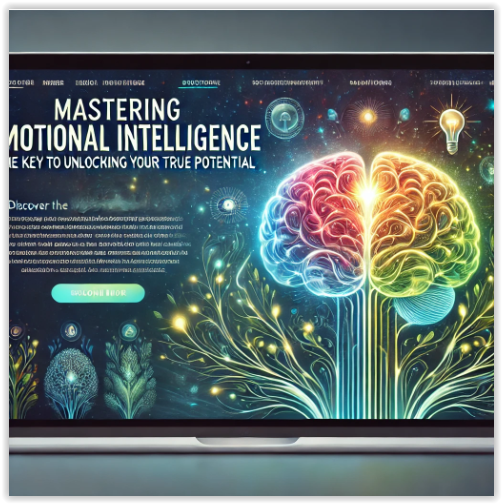Mastering Emotional Intelligence: The Key to Unlocking Your True Potential
“Learn how mastering Emotional Intelligence can help you overcome life’s biggest challenges, enhance your relationships, and unlock your full potential. Discover practical strategies and neuroscience-backed insights today!”
Definition of Emotional Intelligence:
Emotional Intelligence (EI) is the ability to recognize, understand, and manage your own emotions while effectively perceiving and influencing the emotions of others. It is the foundation of personal and professional success, empowering individuals to navigate life’s challenges with resilience, empathy, and clarity.
The Burning Problem
A lack of Emotional Intelligence often results in strained relationships and communication breakdowns—both at work and in personal life. This prevents people from building meaningful connections, hinders collaboration, and leads to unfulfilled potential.
Minor Problems Due to Lack of Emotional Intelligence
- Poor stress management leading to burnout.
- Difficulty in resolving conflicts effectively.
- Low self-awareness causing repeated mistakes.
- Lack of empathy, creating disconnected relationships.
- Poor decision-making under pressure.
- Inability to adapt to change, causing stagnation.
- Reduced productivity and job dissatisfaction.
Scientific Insights into Emotional Intelligence
- Psychological Foundations:
Daniel Goleman, the pioneer of Emotional Intelligence, outlined five core components: self-awareness, self-regulation, motivation, empathy, and social skills. These skills, he found, are critical predictors of success—more so than IQ. - Neuroscience Insights:
The brain’s amygdala governs emotional reactions. Overactivity in the amygdala can trigger impulsive behaviors. Emotional intelligence involves strengthening the prefrontal cortex, responsible for rational decision-making, through techniques like mindfulness and emotional labeling. - Human Behavior Studies:
Research shows that individuals with higher EI are better at interpreting non-verbal cues, navigating social complexities, and fostering collaboration, which are essential for personal and professional growth.
How to Apply Emotional Intelligence to Solve Problems
Concepts, Strategies, and Techniques:
- Enhancing Self-Awareness
- Technique: Maintain a daily journal to track your emotional triggers and responses.
- Example: Write down moments where you felt stressed and analyze the underlying causes.
- Developing Self-Regulation
- Technique: Use the Pause-Breathe-Reflect-Respond (PBRR) method.
- Example: When angered during a meeting, take three deep breaths and respond with a calm perspective.
- Boosting Empathy
- Technique: Practice active listening by paraphrasing and validating others’ emotions.
- Example: During a conflict, say, “I understand you’re feeling frustrated. Let’s find a solution together.”
- Improving Social Skills
- Technique: Use mirror-and-match body language to build rapport.
- Example: During negotiations, subtly mimic the other person’s posture to create subconscious alignment.
- Cultivating Motivation
- Technique: Set small, measurable goals tied to a larger vision.
- Example: If aiming for a promotion, break down the steps into actionable tasks, like improving your presentation skills.
Plan of Action to Build Emotional Intelligence
Step 1: Weekly Emotional Intelligence Audit
- Reflect on your interactions and identify strengths and improvement areas.
Step 2: Practice Emotional Regulation
- Use mindfulness techniques like meditation or progressive muscle relaxation to calm your nervous system.
Step 3: Improve Communication
- Enroll in a public speaking class to refine your ability to articulate thoughts effectively.
Step 4: Build Empathy Through Exposure
- Volunteer in community services or interact with diverse groups to broaden your perspective.
Step 5: Seek Feedback
- Regularly ask friends, family, or mentors for honest feedback about your emotional interactions.
Step 6: Leverage Tools
- Use apps like Headspace for mindfulness or Moodpath for tracking emotional states.
Step 7: Continuous Learning
- Read books like “Emotional Intelligence 2.0” by Travis Bradberry or attend workshops on personal development.
- Learn Decision Making process
- Find your Life Your Life Purpose
- Mastering Communication Skills
Example Case Study
Raj’s Journey to Success Through EI
Raj, a software engineer, struggled with teamwork due to emotional outbursts. After implementing the PBRR method, journaling, and attending workshops, he learned to regulate his emotions, empathize with colleagues, and lead his team effectively. Within a year, Raj was promoted to a leadership position, demonstrating the transformative power of Emotional Intelligence.
Final Thought:
By cultivating Emotional Intelligence, you don’t just solve immediate challenges—you lay the foundation for long-term personal and professional fulfillment. Start today, and take the first step towards living your dream life!

